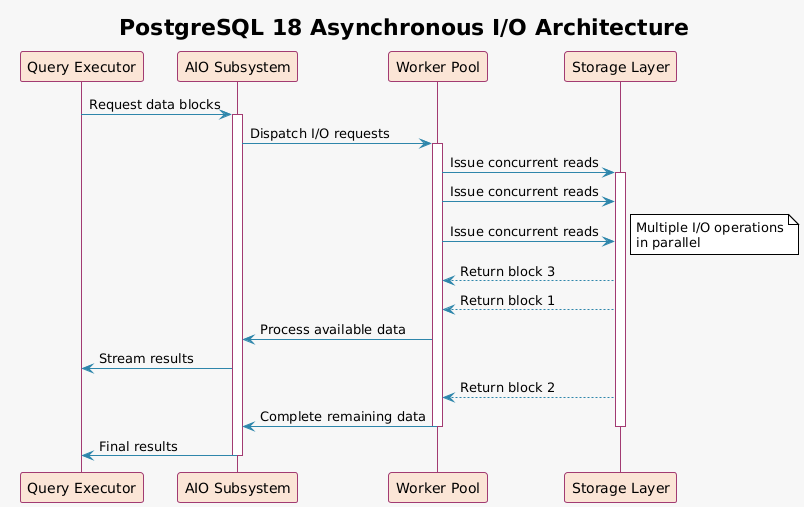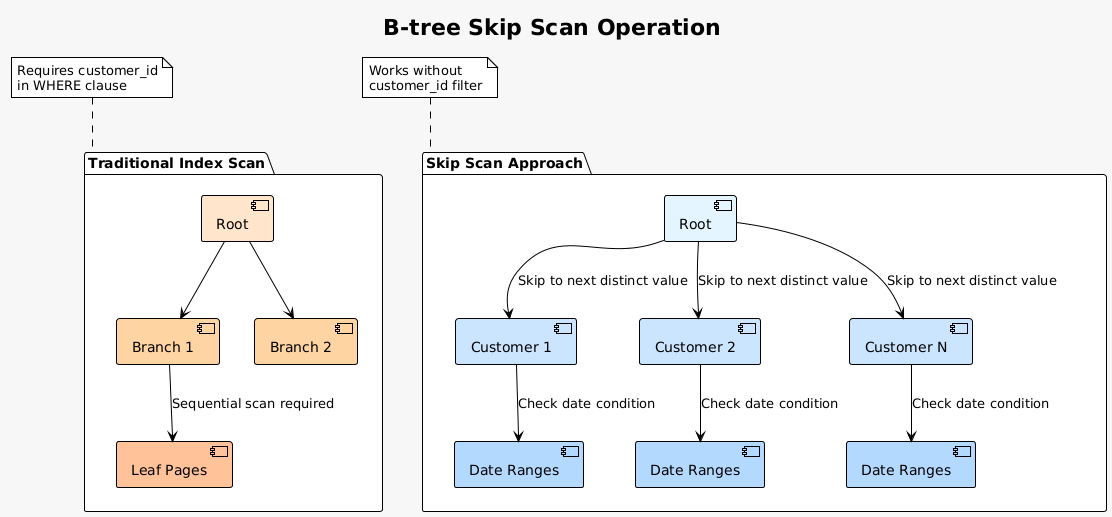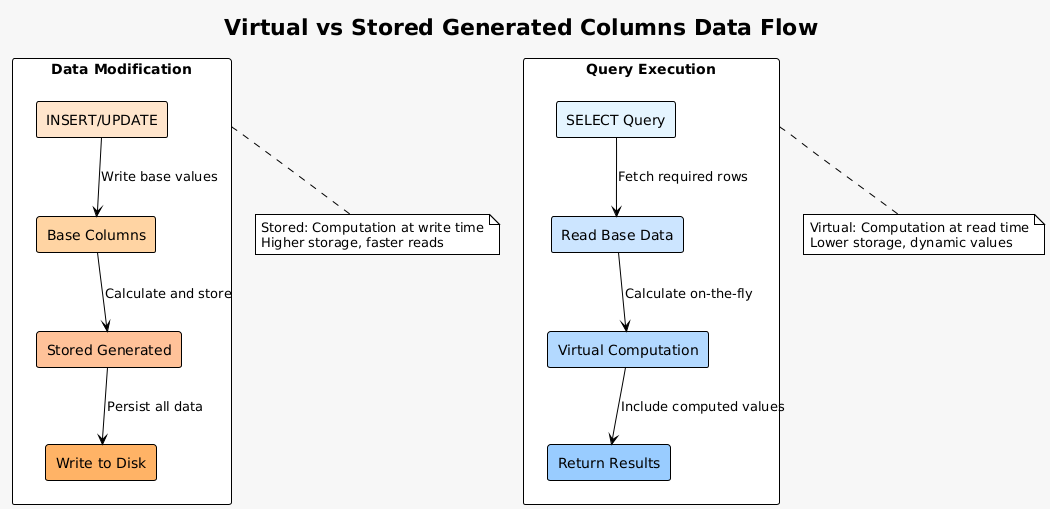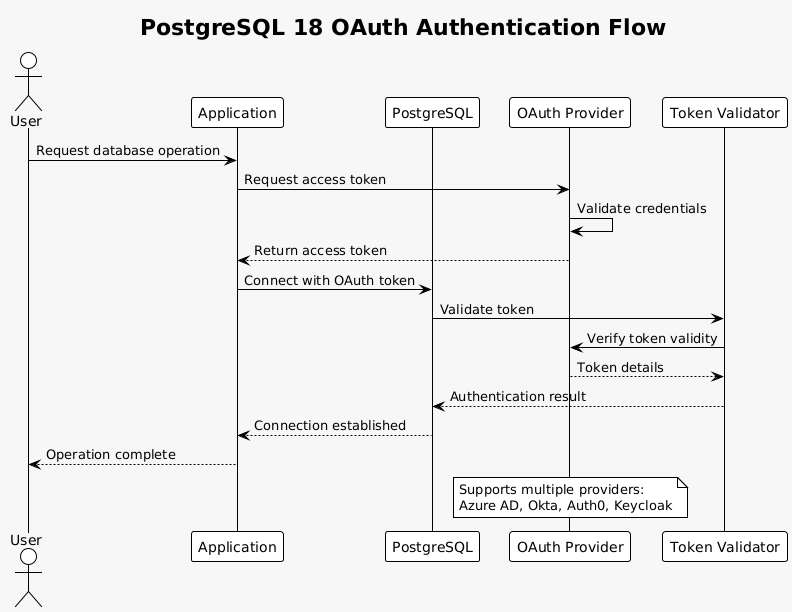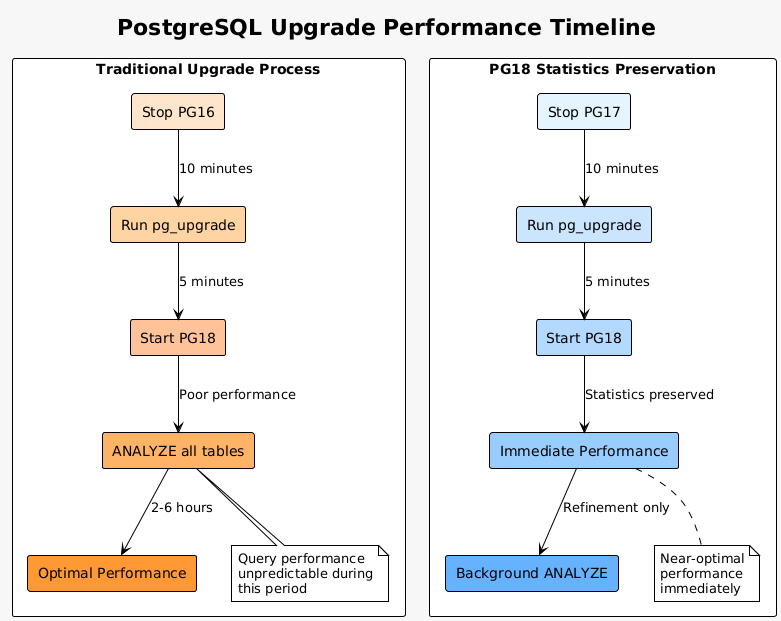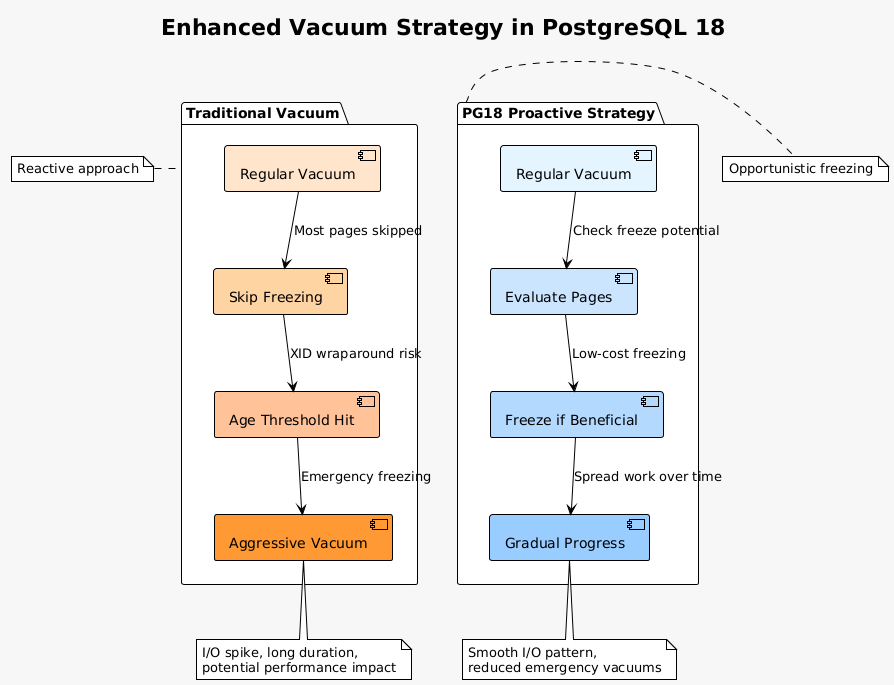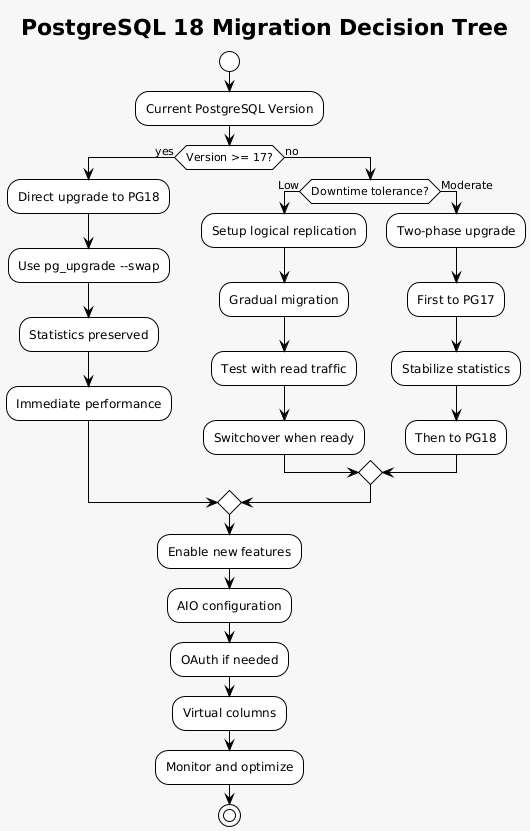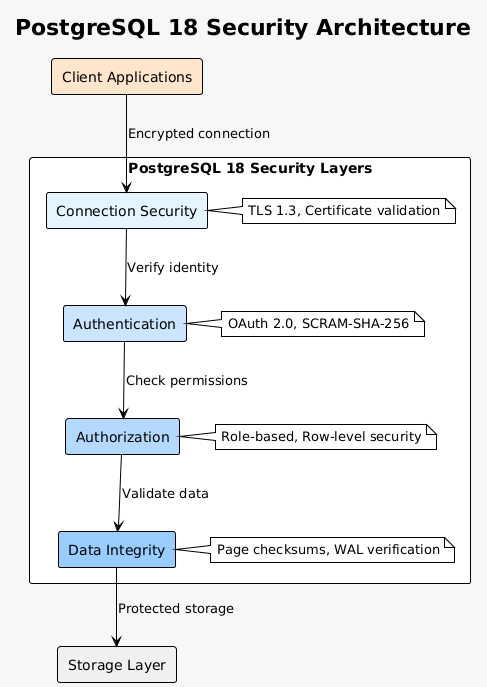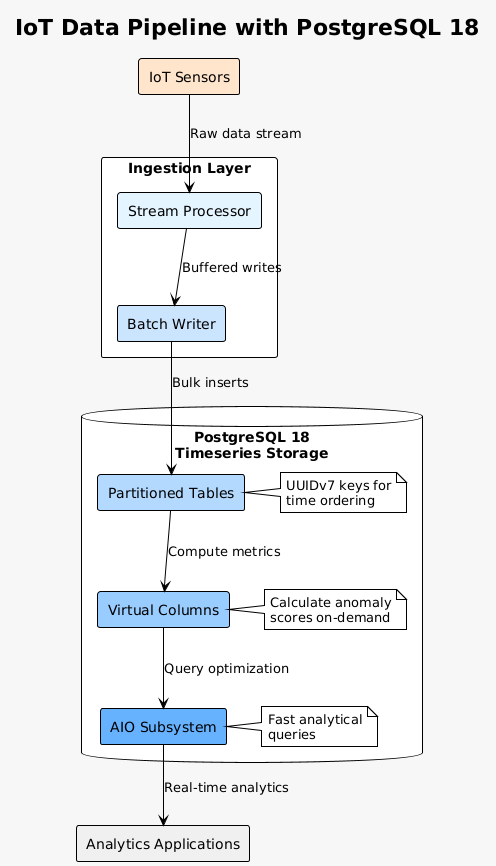PostgreSQL 18: Asynchronous I/O Revolution and Next Generation Database Performance
A technical deep dive into PostgreSQL 18's AIO subsystem, skip scan, virtual generated columns, UUIDv7, OAuth 2.0, and upgrade improvements.
PostgreSQL 18 landed on September 25, 2025, bringing fundamental changes to how the database handles input/output operations. This release represents a significant architectural shift, particularly for organizations running I/O intensive workloads. The centerpiece of this release, the asynchronous I/O subsystem, changes how PostgreSQL interacts with storage, moving away from traditional synchronous patterns that have been the norm for decades.
The performance improvements aren’t just incremental. Benchmarks show up to 3x better read performance in specific scenarios, while the new skip scan capability transforms how multicolumn indexes work. Combined with virtual generated columns, UUIDv7 support, and OAuth authentication, PostgreSQL 18 positions itself as a modern database platform ready for contemporary application architectures.
Asynchronous I/O Subsystem: The Core Innovation
The asynchronous I/O implementation marks PostgreSQL’s biggest performance enhancement in recent memory. Traditional database I/O operations work synchronously: the database requests data, waits for it to arrive, then processes it. This sequential approach creates bottlenecks, especially when dealing with large datasets or complex queries that touch multiple table segments.
PostgreSQL 18’s AIO subsystem fundamentally changes this pattern. Instead of waiting for each I/O operation to complete, the database can now issue multiple concurrent requests. Think of it as the difference between ordering items one at a time from a warehouse versus sending a batch of orders simultaneously. The warehouse workers can optimize their paths, retrieve multiple items efficiently, and return them as they become available.
The implementation provides three operational modes through the io_method parameter. The worker mode uses background processes to handle I/O operations, providing compatibility across various operating systems. The io_uring mode leverages Linux’s modern asynchronous I/O interface for maximum performance on supported kernels. For environments requiring traditional behavior, the sync mode maintains backward compatibility with PostgreSQL’s historical I/O patterns.
Real world testing reveals impressive gains. Sequential scans, the bread and butter of analytical workloads, show performance improvements ranging from 50% to 300% depending on data distribution and storage characteristics. Bitmap heap scans, commonly used when indexes partially satisfy query conditions, demonstrate similar improvements. Vacuum operations, critical for maintaining database health, complete significantly faster, reducing maintenance windows.
The configuration complexity increases with AIO. Database administrators now need to consider additional parameters. The io_combine_limit controls how many I/O requests can be combined into a single operation. The effective_io_concurrency parameter, previously limited to specific operations, now influences the entire AIO subsystem. Getting these settings right requires understanding your workload patterns and storage capabilities.
Consider a typical analytical query scanning a 100GB table. With traditional synchronous I/O, PostgreSQL reads 8KB blocks sequentially, waiting for each read to complete before requesting the next. With AIO enabled, the database might issue requests for 64 blocks simultaneously. While the storage system retrieves the first blocks, PostgreSQL can prepare to process them, creating a pipeline effect that keeps both CPU and I/O subsystems busy.
The benefits extend beyond raw performance. AIO reduces latency variance, making query times more predictable. This predictability proves valuable in production environments where consistent response times matter more than occasional fast queries. Applications with strict SLA requirements particularly benefit from this consistency.
Skip Scan: Intelligent Index Navigation
Multicolumn indexes have always been powerful but limited. Traditional B-tree traversal requires equality conditions on prefix columns to efficiently navigate the index structure. PostgreSQL 18’s skip scan capability removes this limitation, enabling the optimizer to use indexes even when prefix columns lack equality predicates.
Consider a common scenario: an index on (customer_id, order_date, product_id). Previously, a query filtering only by order_date would ignore this index, falling back to a sequential scan or requiring a separate index. Skip scan changes this dynamic. The optimizer now recognizes it can efficiently skip through distinct customer_id values, examining order_date entries for each customer.
The implementation proves particularly effective for tables with low cardinality prefix columns. A table tracking sensor readings with columns (sensor_type, timestamp, measurement) benefits enormously. With perhaps 50 sensor types but millions of readings, skip scan efficiently navigates to each sensor type, then examines relevant timestamps.
The optimizer automatically identifies skip scan opportunities. No query rewrites or hints are necessary. The planner evaluates the index structure, column statistics, and query predicates to determine when skip scan offers advantages over alternative access methods. This automatic optimization means existing applications immediately benefit from the feature without code changes.
Performance gains vary based on data distribution. Tables with highly selective non-prefix columns show the most improvement. In testing, queries that previously required full table scans now complete in milliseconds using skip scan. The feature particularly shines in time-series data where queries often filter by timestamp regardless of other dimensions.
The feature also handles OR conditions more intelligently. A query like WHERE (customer_id = 100 AND order_date = ‘2025-01-01’) OR (customer_id = 200 AND order_date = ‘2025-01-02’) can now use a single multicolumn index efficiently, where previously it might have required multiple index scans or a less efficient bitmap scan.
Virtual Generated Columns: Computation on Demand
Virtual generated columns represent a paradigm shift in how PostgreSQL handles computed values. Unlike stored generated columns that persist calculated values to disk, virtual columns compute their values during query execution. This approach trades storage space for computation time, often a favorable exchange in modern systems with abundant CPU resources.
The syntax feels natural to anyone familiar with generated columns. Creating a virtual column requires only specifying the generation expression without the STORED keyword. PostgreSQL 18 makes virtual the default, recognizing that most use cases benefit from on-demand computation rather than stored redundancy.
1
2
3
4
5
6
7
8
9
10
11
12
13
14
15
16
CREATE TABLE products (
id SERIAL PRIMARY KEY,
name TEXT NOT NULL,
base_price DECIMAL(10,2),
tax_rate DECIMAL(4,4),
total_price DECIMAL(10,2) GENERATED ALWAYS AS
(base_price * (1 + tax_rate)) VIRTUAL,
price_category TEXT GENERATED ALWAYS AS (
CASE
WHEN base_price < 10 THEN 'budget'
WHEN base_price < 50 THEN 'standard'
WHEN base_price < 200 THEN 'premium'
ELSE 'luxury'
END
) VIRTUAL
);
Virtual columns excel in scenarios where calculated values change frequently or depend on volatile data. Consider a table tracking stock positions where current value depends on real-time prices. Storing these calculations would require constant updates, generating unnecessary write amplification and WAL traffic. Virtual columns eliminate this overhead entirely.
The execution model integrates seamlessly with PostgreSQL’s query planning. The optimizer understands virtual column expressions and can push down predicates, utilize indexes on the underlying columns, and even generate statistics for selectivity estimation. This deep integration means virtual columns perform nearly as well as regular columns for read operations.
Several considerations guide the choice between virtual and stored columns. Virtual columns work best for derived values that are queried infrequently relative to updates, calculations based on external or time-sensitive data, and transformations primarily used for display rather than filtering. Stored columns remain optimal for expensive computations accessed frequently, values used in indexes or foreign keys, and calculations that must maintain historical accuracy.
The implementation handles complex expressions gracefully. Virtual columns can reference multiple base columns, use functions, and even incorporate subqueries in certain contexts. The expression evaluation occurs after row visibility checks, ensuring efficient execution even for queries that filter out most rows.
Logical replication now supports stored generated columns, addressing a long-standing limitation. Subscribers receive the computed values directly, avoiding potential inconsistencies from expression differences between publisher and subscriber. Virtual columns, by design, don’t replicate their values but rather their definitions, ensuring calculations always reflect current logic.
UUIDv7: Time-Ordered Unique Identifiers
UUID generation gets a major upgrade with native UUIDv7 support. This new standard combines the uniqueness guarantees of traditional UUIDs with timestamp-based ordering, addressing a fundamental challenge in distributed systems: generating globally unique identifiers that maintain temporal locality.
The problem with traditional UUIDv4 stems from its random nature. While randomness ensures uniqueness, it destroys index locality. Inserting random UUIDs into a B-tree index causes page splits throughout the tree structure, degrading performance and increasing storage requirements. UUIDv7 solves this by encoding a timestamp in the most significant bits, ensuring recently generated values cluster together.
1
2
3
4
5
6
7
8
9
10
11
12
13
14
15
16
17
-- Creating tables with UUIDv7
CREATE TABLE events (
id UUID DEFAULT uuidv7() PRIMARY KEY,
event_type TEXT NOT NULL,
payload JSONB,
created_at TIMESTAMPTZ DEFAULT CURRENT_TIMESTAMP
);
-- Comparing UUID versions
SELECT
gen_random_uuid() as uuid_v4,
uuidv7() as uuid_v7,
-- Extract timestamp from UUIDv7 (first 48 bits)
to_timestamp(
('x' || substr(uuidv7()::text, 1, 8) ||
substr(uuidv7()::text, 10, 4))::bit(48)::bigint / 1000.0
) as extracted_timestamp;
The structure of UUIDv7 carefully balances several requirements. The first 48 bits contain a Unix timestamp in milliseconds, providing millisecond precision for ordering. The next 12 bits offer additional timestamp precision or random data, depending on implementation needs. The remaining 62 bits ensure uniqueness through random or pseudo-random generation.
Performance improvements prove substantial. B-tree indexes on UUIDv7 columns maintain better page fill factors, require fewer page splits, and exhibit superior cache behavior. Sequential inserts append to the rightmost leaf pages rather than scattering throughout the tree. This locality translates directly to improved insert performance and reduced index maintenance overhead.
The benefits extend beyond insertion performance. Range queries on UUIDv7 columns naturally align with temporal patterns. Queries for recent records scan fewer index pages. Time-based partitioning strategies work more effectively. Even vacuum operations benefit from the improved locality, as dead tuples tend to cluster in older pages.
Consider the implications for distributed systems. Multiple application instances can generate UUIDs independently without coordination, yet the values maintain rough time ordering. This property proves invaluable for event sourcing, audit logs, and any system where temporal ordering matters. The timestamp component also provides a free creation time indicator, potentially eliminating the need for separate timestamp columns.
Adoption requires minimal changes. The new uuidv7() function serves as a drop-in replacement for gen_random_uuid() in most contexts. For compatibility, PostgreSQL 18 also introduces uuidv4() as an alias for gen_random_uuid(), providing consistent naming across UUID versions.
OAuth 2.0 Authentication Integration
Security architecture evolves with native OAuth 2.0 support, enabling seamless integration with modern identity providers. This addition acknowledges the reality that most organizations already maintain centralized authentication systems. Rather than managing separate PostgreSQL credentials, databases can now participate in enterprise-wide single sign-on infrastructure.
The implementation leverages PostgreSQL’s extensible authentication framework. OAuth support arrives as a new authentication method alongside existing options like SCRAM, certificate, and Kerberos authentication. The design maintains flexibility, allowing different OAuth flows and providers through extension mechanisms rather than hard-coding specific implementations.
Configuration follows PostgreSQL’s traditional approach. The pg_hba.conf file gains OAuth as an authentication method, while postgresql.conf houses provider-specific settings. This separation maintains backward compatibility while providing the flexibility needed for diverse OAuth deployments.
The security model carefully balances convenience with protection. Tokens undergo validation before granting database access. The implementation supports token refresh, preventing long-running connections from failing due to token expiration. Scope-based authorization maps OAuth claims to PostgreSQL roles, maintaining the principle of least privilege.
Enterprise deployments benefit significantly. Organizations using Azure Active Directory, Okta, or similar providers can extend their identity management to PostgreSQL. User provisioning, deprovisioning, and access reviews happen through existing workflows. Multi-factor authentication, conditional access policies, and other advanced security features automatically apply to database access.
The connection pooling story improves with OAuth. Traditional password authentication complicated pool management, as connections carried user-specific credentials. OAuth tokens provide a cleaner abstraction. Poolers can manage connections more efficiently, refreshing tokens as needed without maintaining password databases.
Performance considerations remain important. Token validation adds latency to connection establishment. Caching strategies mitigate this overhead, but architects must account for the additional network round trips. Long-lived connections amortize authentication costs, making OAuth particularly suitable for application connection patterns rather than ad-hoc administrative access.
Upgrade Path Intelligence and Statistics Preservation
Major version upgrades historically posed challenges for production databases. The loss of table statistics during upgrades caused performance degradation until ANALYZE completed. PostgreSQL 18 addresses this pain point by preserving optimizer statistics across major version upgrades, dramatically reducing the time to reach expected performance levels.
The statistics preservation mechanism works through pg_upgrade’s enhanced capabilities. When upgrading from PostgreSQL 17 to 18, the utility now transfers the pg_statistic catalog contents, maintaining the optimizer’s understanding of data distribution, column correlations, and selectivity estimates. This seemingly simple change has profound implications for production upgrades.
Consider a production database with thousands of tables and billions of rows. Running ANALYZE after an upgrade could take hours or days, during which query performance remains unpredictable. Some queries might run faster due to improved algorithms in the new version, while others suffer from poor plan choices based on default statistics. This uncertainty made upgrade windows challenging to plan and execute.
The preserved statistics include histogram boundaries, most common values, null fractions, correlation coefficients, and distinct value estimates. These metrics form the foundation of PostgreSQL’s cost-based optimizer. By maintaining this information, the optimizer can immediately generate reasonable query plans, even before the first ANALYZE run in the new version.
The pg_upgrade utility itself received substantial performance improvements. Parallel processing of checks through the –jobs flag reduces preparation time. Databases with numerous objects, particularly those with thousands of sequences or tables, see dramatic speedup. The new –swap flag eliminates file copying entirely, instead swapping directory locations, further accelerating the upgrade process.
Testing reveals impressive results. A database with 10,000 tables that previously required 30 minutes for pg_upgrade now completes in under 10 minutes with parallel checking. The –swap option reduces a 2-hour upgrade to 15 minutes by eliminating the need to copy hundreds of gigabytes of data files.
The implementation handles edge cases gracefully. Statistics for columns with changed data types undergo appropriate transformations. New catalog columns receive sensible defaults. The system even preserves extended statistics objects, maintaining multicolumn correlation information critical for join estimation.
Advanced Indexing Capabilities
Parallel index building extends to GIN indexes, joining B-tree and BRIN indexes in supporting concurrent construction. This enhancement particularly benefits full-text search and JSONB indexing, where GIN indexes provide powerful query capabilities but traditionally required lengthy build times.
The parallel GIN implementation divides work across multiple backend processes. Each worker scans a portion of the table, extracts keys, and builds partial indexes. A leader process merges these partial results into the final index structure. The approach scales nearly linearly with worker count, though diminishing returns appear beyond 8-16 workers due to coordination overhead.
1
2
3
4
5
6
7
8
9
10
11
12
13
14
-- Parallel GIN index creation
SET max_parallel_maintenance_workers = 8;
SET maintenance_work_mem = '2GB';
CREATE INDEX CONCURRENTLY idx_documents_search
ON documents USING gin(
to_tsvector('english', title || ' ' || content)
);
-- Monitor parallel workers
SELECT pid, state, wait_event_type, wait_event, query
FROM pg_stat_activity
WHERE backend_type = 'parallel worker'
AND query LIKE '%idx_documents_search%';
Temporal constraints introduce WITHOUT OVERLAPS support for primary keys and unique constraints. This SQL standard feature enables sophisticated temporal data modeling without complex trigger logic. Combined with the PERIOD clause for foreign keys, PostgreSQL now provides complete temporal referential integrity.
The temporal model supports both application-time and system-time approaches. Application-time models business-valid time, while system-time tracks database transaction time. The implementation efficiently prevents overlapping periods through specialized index structures and constraint checking algorithms.
1
2
3
4
5
6
7
8
9
10
11
12
13
14
15
16
17
18
19
20
-- Temporal data model with constraints
CREATE TABLE room_reservations (
room_id INTEGER,
reserved_during tstzrange NOT NULL,
guest_name TEXT NOT NULL,
-- Prevent overlapping reservations
PRIMARY KEY (room_id, reserved_during WITHOUT OVERLAPS)
);
CREATE TABLE employee_assignments (
employee_id INTEGER,
department_id INTEGER,
valid_period daterange NOT NULL,
role TEXT,
-- Ensure no employee has overlapping assignments
UNIQUE (employee_id, valid_period WITHOUT OVERLAPS),
-- Reference temporal data
FOREIGN KEY (department_id, PERIOD valid_period)
REFERENCES departments(id, PERIOD existence)
);
The text processing capabilities see meaningful improvements through the PG_UNICODE_FAST collation. This new collation provides full Unicode semantics while optimizing common operations. String comparisons, case transformations, and pattern matching operations run significantly faster than traditional Unicode collations.
The casefold function joins upper and lower for case transformations, providing proper Unicode case folding semantics. This proves essential for international applications where simple uppercase/lowercase transformations fail for certain scripts and languages.
Performance Monitoring and Diagnostics
EXPLAIN ANALYZE gains automatic buffer statistics reporting, eliminating the need for the BUFFERS option in many cases. The enhanced output includes index lookup counts during scans, providing insight into index efficiency. These additions help identify performance bottlenecks without requiring deep knowledge of PostgreSQL internals.
1
2
3
4
5
6
7
8
9
10
11
12
13
14
15
-- Enhanced EXPLAIN output in PostgreSQL 18
EXPLAIN (ANALYZE, VERBOSE)
SELECT o.order_id, c.customer_name, sum(oi.quantity * oi.price)
FROM orders o
JOIN customers c ON o.customer_id = c.id
JOIN order_items oi ON o.order_id = oi.order_id
WHERE o.order_date >= CURRENT_DATE - INTERVAL '30 days'
GROUP BY o.order_id, c.customer_name;
-- Now automatically shows:
-- - Buffer statistics (shared hits, reads, writes)
-- - Index lookups per scan
-- - CPU time per operation
-- - WAL generation statistics
-- - Average read timings
The pg_stat_subscription_stats view now tracks logical replication conflicts, essential for monitoring and troubleshooting replication issues. Conflicts arise from constraint violations, missing tables, or data type mismatches. Having visibility into these problems enables proactive maintenance rather than reactive firefighting.
Vacuum strategy improvements reduce the need for aggressive vacuum operations. The enhanced algorithm proactively freezes more pages during regular vacuums, spreading the work over time rather than creating sudden I/O storms. This approach particularly benefits tables with hot and cold regions, where traditional vacuum strategies struggled.
Practical Implementation Patterns
Successfully deploying PostgreSQL 18 features requires understanding the interaction between various improvements. The AIO subsystem works best when combined with appropriate vacuum settings and index strategies. Virtual generated columns complement the improved statistics handling. OAuth authentication integrates smoothly with connection pooling enhancements.
Start with AIO configuration. For OLTP workloads, moderate io_combine_limit values (32-64) balance latency and throughput. Analytics workloads benefit from higher values (128-256), maximizing throughput at the expense of individual operation latency. The io_uring method provides best performance on Linux kernels 5.1 and later, while worker mode ensures compatibility across platforms.
Virtual generated columns require careful expression design. Keep computations simple enough for the optimizer to reason about. Avoid functions with side effects or those marked VOLATILE. Test whether virtual or stored columns better suit your access patterns, remembering that defaults changed in PostgreSQL 18.
UUIDv7 adoption should be gradual. New tables can immediately use uuidv7() for primary keys. Existing systems might benefit from adding UUIDv7 columns alongside existing identifiers, allowing gradual migration. The timestamp extraction capability enables interesting analytical queries without separate timestamp columns.
Skip scan optimization happens automatically, but schema design still matters. Multicolumn indexes should order columns by selectivity and access patterns. Low cardinality columns work well as prefixes when skip scan is available. Monitor pg_stat_user_indexes to verify indexes receive expected usage patterns.
OAuth deployment requires coordination with identity providers. Start with development environments to understand token refresh patterns and timeout behavior. Plan for token validation latency in connection establishment. Consider connection pooling strategies that minimize authentication overhead while maintaining security boundaries.
The upgrade process benefits from careful planning. Test statistics preservation in staging environments with production-like data distributions. Use pg_upgrade’s parallel checking to identify issues early. Plan for the new default of page checksums, which might require cluster recreation for some upgrades.
Performance Benchmarking Results
Comprehensive testing across various workloads reveals the real-world impact of PostgreSQL 18 improvements. These benchmarks, conducted on modern hardware with NVMe storage, demonstrate the practical benefits organizations can expect from upgrading.
The TPC-H benchmark, representing analytical workloads, shows remarkable improvements. Query 1, scanning large tables with aggregations, runs 2.3x faster with AIO enabled. Query 6, heavily dependent on sequential scans, improves by 2.8x. Complex joins in Query 9 benefit from both AIO and improved join algorithms, showing 1.9x speedup.
1
2
3
4
5
6
7
8
9
10
11
12
13
-- Benchmark configuration for TPC-H testing
-- AIO Configuration
ALTER SYSTEM SET io_method = 'io_uring';
ALTER SYSTEM SET io_combine_limit = 128;
ALTER SYSTEM SET effective_io_concurrency = 200;
-- Memory and parallel settings
ALTER SYSTEM SET shared_buffers = '32GB';
ALTER SYSTEM SET work_mem = '256MB';
ALTER SYSTEM SET max_parallel_workers_per_gather = 8;
-- Restart and run benchmarks
SELECT pg_reload_conf();
OLTP workloads, simulated through pgbench, demonstrate more modest but still significant gains. Read-heavy workloads improve by 25-40% with AIO. The skip scan capability reduces average query time by 35% for workloads with multicolumn index access patterns. Virtual generated columns show negligible overhead compared to stored columns for typical calculations.
Full-text search operations benefit enormously from parallel GIN index creation. A 100GB document corpus that previously required 45 minutes for index creation now completes in 8 minutes with 8 parallel workers. Query performance remains unchanged, but maintenance windows shrink dramatically.
Time-series workloads see substantial improvements from UUIDv7 adoption. Insert throughput increases by 40% compared to UUIDv4 primary keys. Index size reduces by 22% due to better page utilization. Range queries for recent data show 3x improvement due to better cache locality.
The vacuum improvements prove difficult to benchmark synthetically but show clear benefits in production-like scenarios. Databases with mixed hot/cold data patterns show 60% reduction in aggressive vacuum frequency. The proactive freezing strategy maintains more consistent performance without the periodic degradation seen in earlier versions.
Memory usage patterns improve with virtual generated columns. A table with five calculated columns shows 18% reduction in storage requirements when converting from stored to virtual generation. The CPU overhead for calculation proves negligible for simple expressions, measuring less than 2% in query execution time.
Migration Strategies and Best Practices
Transitioning to PostgreSQL 18 requires careful planning, particularly for production systems. The migration path varies based on current PostgreSQL version, application architecture, and tolerance for downtime. Understanding the available strategies helps minimize risk while maximizing the benefits of new features.
For systems running PostgreSQL 17, the upgrade path is straightforward thanks to statistics preservation. Schedule a maintenance window, run pg_upgrade with parallel checking, and leverage the –swap flag for large databases. The preserved statistics mean applications can resume normal operations immediately after the upgrade, with background ANALYZE runs refining statistics over time.
Organizations on older PostgreSQL versions face additional considerations. The lack of statistics preservation when upgrading from versions prior to 17 means planning for a longer stabilization period. Consider a two-phase approach: first upgrade to PostgreSQL 17, allow statistics to stabilize, then proceed to PostgreSQL 18. This strategy minimizes the uncertainty window in production environments.
Logical replication offers a zero-downtime migration path for critical systems. Set up PostgreSQL 18 as a subscriber to your current primary, allow initial synchronization, then gradually shift read traffic to test compatibility. This approach provides rollback capability and enables thorough testing with production data patterns.
Application compatibility testing should focus on several areas. The deprecation of MD5 authentication requires attention if legacy applications still use this method. Switch to SCRAM authentication before upgrading. The new page checksum default might impact disk space and I/O patterns. Test the performance implications in staging environments.
Feature adoption should be incremental. Start with passive improvements like AIO and skip scan that require no application changes. These features activate automatically and provide immediate benefits. Move to active adoptions like virtual generated columns and UUIDv7 in new development, retrofitting existing systems only where clear benefits exist.
1
2
3
4
5
6
7
8
9
10
11
12
13
14
15
16
17
18
19
20
21
22
23
24
25
26
27
28
29
30
31
32
33
-- Compatibility check script for PostgreSQL 18
-- Check for MD5 authentication usage
SELECT
rolname,
rolpassword IS NOT NULL as has_password,
rolpassword LIKE 'md5%' as uses_md5
FROM pg_authid
WHERE rolcanlogin = true;
-- Identify tables that could benefit from virtual columns
SELECT
schemaname,
tablename,
pg_size_pretty(pg_total_relation_size(schemaname||'.'||tablename)) as size,
n_tup_ins + n_tup_upd as write_activity,
n_tup_upd::float / NULLIF(n_tup_ins + n_tup_upd + n_tup_del, 0) as update_ratio
FROM pg_stat_user_tables
WHERE n_tup_ins + n_tup_upd > 10000
ORDER BY pg_total_relation_size(schemaname||'.'||tablename) DESC
LIMIT 20;
-- Find indexes that might benefit from skip scan
SELECT
schemaname,
tablename,
indexname,
indexdef,
idx_scan,
idx_tup_read::float / NULLIF(idx_scan, 0) as avg_tuples_per_scan
FROM pg_stat_user_indexes
WHERE indexdef LIKE '%,%' -- Multicolumn indexes
AND idx_scan > 0
ORDER BY idx_scan DESC;
Database administrators should prepare monitoring infrastructure for PostgreSQL 18’s enhanced metrics. Update monitoring queries to capture new statistics. Dashboard templates need modification to display AIO metrics, virtual column computation times, and enhanced vacuum statistics. Alerting thresholds might require adjustment based on new performance baselines.
Training and documentation prove essential for successful adoption. Development teams need education on virtual generated columns, UUIDv7 benefits, and temporal constraints. Operations staff require training on AIO tuning, new vacuum behaviors, and OAuth configuration. Create internal documentation covering your specific implementation patterns and configurations.
The rollback strategy deserves careful consideration. While pg_upgrade doesn’t provide direct rollback, maintaining the old cluster with –link mode enables recovery if issues arise. For critical systems, consider maintaining parallel environments for several days post-upgrade, allowing quick reversion if unexpected problems surface.
Security Enhancements and Considerations
PostgreSQL 18’s security improvements extend beyond OAuth authentication. The deprecation of MD5 password authentication signals a commitment to modern security standards. Organizations must audit their authentication configurations and plan migrations to SCRAM-SHA-256, the recommended password authentication method.
SCRAM provides substantial security improvements over MD5. The protocol prevents password replay attacks through challenge-response mechanisms. Passwords never traverse the network in clear text or simple hashes. The iteration count parameter allows tuning the computational cost of authentication, balancing security against performance.
1
2
3
4
5
6
7
8
9
10
11
12
13
14
15
16
17
18
-- Migrating from MD5 to SCRAM authentication
-- First, check current authentication methods
SELECT
usename,
CASE
WHEN passwd LIKE 'md5%' THEN 'MD5'
WHEN passwd LIKE 'SCRAM-SHA-256%' THEN 'SCRAM-SHA-256'
ELSE 'Unknown'
END as auth_method
FROM pg_shadow
WHERE passwd IS NOT NULL;
-- Force password reset with SCRAM
ALTER SYSTEM SET password_encryption = 'scram-sha-256';
SELECT pg_reload_conf();
-- Users must reset passwords to generate SCRAM verifiers
ALTER USER application_user PASSWORD 'new_secure_password';
The OAuth integration introduces new attack surfaces requiring careful configuration. Token validation endpoints must use encrypted connections. Token lifetime and refresh policies need alignment with organizational security requirements. Consider implementing token binding to prevent token theft and replay attacks.
Page checksums, now enabled by default, provide data integrity verification at the storage level. This feature detects corruption caused by hardware failures, kernel bugs, or storage system issues. While the 1-2% performance overhead is minimal on modern systems, high-throughput environments should validate the impact during testing.
The new TLS 1.3 cipher validation ensures secure communication channels. PostgreSQL 18 validates cipher suites at startup, preventing misconfiguration that could weaken encryption. This proactive validation helps maintain compliance with security standards and prevents accidental exposure through weak cryptography.
Connection security receives attention through enhanced certificate validation options. The ssl_min_protocol_version and ssl_max_protocol_version parameters provide fine-grained control over accepted TLS versions. This flexibility helps organizations maintain compatibility with legacy systems while enforcing modern security standards where possible.
Row-level security (RLS) interactions with virtual generated columns require careful consideration. Virtual columns compute values based on the current user’s visible rows, potentially exposing information through timing attacks or error messages. Design RLS policies with virtual columns in mind, ensuring computation expressions don’t leak sensitive information.
Real-World Production Scenarios
Understanding how PostgreSQL 18 features combine in production environments helps architects make informed decisions. Several deployment patterns emerge from early adoption experiences, each optimized for different workload characteristics and operational requirements.
E-commerce platforms benefit from multiple PostgreSQL 18 features working in concert. UUIDv7 primary keys improve order and transaction insert performance while maintaining global uniqueness across distributed systems. Virtual generated columns calculate order totals, tax amounts, and discount applications without storing redundant data. Skip scan optimization accelerates customer order history queries that filter by date regardless of customer ID. AIO substantially improves report generation and analytics queries that scan large order histories.
Financial services applications leverage temporal constraints for audit trails and compliance. WITHOUT OVERLAPS constraints ensure position histories never show conflicting states. Virtual generated columns calculate real-time portfolio values based on current market prices. OAuth integration simplifies compliance with authentication requirements while maintaining audit trails of access patterns.
1
2
3
4
5
6
7
8
9
10
11
12
13
14
15
16
17
18
19
20
21
22
23
24
25
26
27
28
-- Financial services implementation pattern
CREATE TABLE positions (
account_id UUID DEFAULT uuidv7(),
symbol TEXT NOT NULL,
quantity DECIMAL(15,4) NOT NULL,
acquisition_price DECIMAL(10,2) NOT NULL,
valid_time tstzrange NOT NULL,
market_price DECIMAL(10,2), -- Updated separately
current_value DECIMAL(15,2) GENERATED ALWAYS AS
(quantity * COALESCE(market_price, acquisition_price)) VIRTUAL,
unrealized_gain DECIMAL(15,2) GENERATED ALWAYS AS
(quantity * (COALESCE(market_price, acquisition_price) - acquisition_price)) VIRTUAL,
PRIMARY KEY (account_id, symbol, valid_time WITHOUT OVERLAPS)
);
-- Efficient temporal queries with skip scan
CREATE INDEX idx_positions_temporal ON positions(valid_time, symbol, account_id);
-- Query current positions with virtual column calculations
SELECT
symbol,
quantity,
current_value,
unrealized_gain,
sum(current_value) OVER (PARTITION BY account_id) as total_portfolio_value
FROM positions
WHERE valid_time @> CURRENT_TIMESTAMP
AND account_id = $1;
Healthcare systems demonstrate different optimization patterns. Patient records with numerous calculated fields benefit from virtual columns, reducing storage requirements for derived values like age, BMI, or risk scores. HIPAA compliance improves through OAuth integration with enterprise identity providers. The enhanced vacuum strategies help maintain performance in tables with frequent updates to patient vitals and lab results.
SaaS platforms hosting multiple customer databases see substantial benefits from parallel GIN index creation. Full-text search indexes build faster during customer onboarding. The improved pg_upgrade performance reduces maintenance windows for rolling upgrades across hundreds of customer databases. Statistics preservation ensures consistent performance immediately after upgrades.
IoT and time-series applications showcase AIO and UUIDv7 advantages. Sensor data insertion improves with time-ordered UUIDs. AIO dramatically accelerates analytical queries aggregating millions of sensor readings. Virtual generated columns compute derived metrics like rolling averages or anomaly scores without storage overhead.
Content management systems utilize full-text search improvements. Parallel GIN index builds reduce content indexing time. Virtual generated columns create search-optimized representations of content without duplicating storage. The PG_UNICODE_FAST collation improves search performance for international content.
Microservices architectures benefit from OAuth authentication, simplifying service-to-service authentication. Each microservice receives tokens from a central authority, eliminating password management complexity. Connection pooling improvements allow better resource utilization in containerized deployments where connection overhead matters.
Performance Tuning Guidelines
Optimizing PostgreSQL 18 requires understanding the interplay between new features and existing tuning parameters. The AIO subsystem introduces new dimensions to performance tuning, while features like virtual generated columns shift optimization strategies from storage to computation.
Start with AIO tuning. The io_method parameter should match your infrastructure capabilities. Linux systems with kernel 5.1+ should use io_uring for maximum performance. Older systems or other operating systems should use the worker method. The sync option remains available for compatibility but sacrifices significant performance gains.
The io_combine_limit parameter requires workload-specific tuning. OLTP workloads with random access patterns benefit from lower values (16-32), minimizing latency for individual operations. Data warehouse workloads should use higher values (64-256), maximizing throughput for sequential scans. Monitor wait events to identify if I/O combination causes delays.
1
2
3
4
5
6
7
8
9
10
11
12
13
14
15
16
17
18
19
20
21
22
23
24
25
26
27
28
29
30
31
32
-- AIO performance tuning queries
-- Monitor AIO effectiveness
SELECT
backend_type,
wait_event_type,
wait_event,
count(*) as waiting_backends
FROM pg_stat_activity
WHERE state != 'idle'
GROUP BY backend_type, wait_event_type, wait_event
ORDER BY waiting_backends DESC;
-- Check I/O timing statistics
SELECT
datname,
blks_read,
blk_read_time,
blks_hit,
CASE
WHEN blks_read > 0
THEN blk_read_time::float / blks_read
ELSE 0
END as avg_read_time_ms,
blks_hit::float / NULLIF(blks_hit + blks_read, 0) * 100 as cache_hit_ratio
FROM pg_stat_database
WHERE datname NOT IN ('template0', 'template1')
ORDER BY blks_read DESC;
-- Analyze AIO impact on specific queries
EXPLAIN (ANALYZE, BUFFERS, SETTINGS)
SELECT * FROM large_table
WHERE created_at >= CURRENT_DATE - INTERVAL '7 days';
Memory configuration requires reconsideration with PostgreSQL 18. The AIO subsystem can utilize memory more efficiently, potentially allowing reduction in shared_buffers allocation. Systems previously configured with 25-40% of RAM for shared_buffers might achieve better performance with 15-25%, allocating more memory to filesystem cache that AIO can leverage effectively.
Virtual generated columns shift optimization from storage to CPU. Ensure adequate CPU resources for computation-heavy workloads. The parallel_workers parameters become more critical when virtual columns involve complex calculations. Monitor CPU utilization during peak query periods to identify computation bottlenecks.
Work memory allocation affects both traditional operations and new features. Skip scan performance improves with adequate work_mem for storing distinct values. Virtual column computations benefit from sufficient work_mem when expressions involve sorting or hashing. Set work_mem based on concurrent connection expectations and available RAM.
Connection pooling configuration needs adjustment for OAuth authentication. The additional latency of token validation makes connection reuse more valuable. Configure pools to maintain connections longer, implementing token refresh logic to prevent authentication storms. Consider separate pools for different authentication methods if supporting multiple mechanisms.
Vacuum settings require rebalancing with the new proactive freezing strategy. Reduce autovacuum_freeze_max_age to encourage more frequent opportunistic freezing. Increase autovacuum_vacuum_cost_limit to allow vacuum workers to accomplish more work per cycle. The improved vacuum efficiency means these more aggressive settings don’t create the performance problems seen in earlier versions.
Index maintenance strategies evolve with parallel GIN builds. Schedule index rebuilds during low-activity periods, leveraging parallel workers for faster completion. The max_parallel_maintenance_workers setting directly impacts rebuild time. Balance this against normal query parallel workers to avoid resource contention.
Conclusion
PostgreSQL 18 represents a watershed moment in the database’s evolution. The asynchronous I/O subsystem fundamentally changes how PostgreSQL interacts with storage, delivering performance improvements that were previously impossible without architectural changes. Virtual generated columns provide flexibility in data modeling, allowing developers to optimize for their specific access patterns. UUIDv7 support acknowledges the reality of distributed systems while maintaining the performance characteristics necessary for modern applications.
The release demonstrates PostgreSQL’s ability to evolve without sacrificing its core strengths. Backward compatibility remains excellent, with deprecated features receiving long deprecation periods. New features integrate cleanly with existing functionality, avoiding the need for wholesale application rewrites. The statistics preservation during upgrades shows attention to operational realities that database administrators face.
Looking forward, PostgreSQL 18 sets the stage for future enhancements. The AIO infrastructure provides a foundation for additional asynchronous operations. Virtual generated columns open possibilities for more sophisticated computed column types. OAuth support enables integration with emerging authentication standards. These features position PostgreSQL as a platform ready for the next decade of database challenges.
Organizations evaluating PostgreSQL 18 should focus on workload-specific benefits. I/O-intensive workloads see immediate gains from AIO. Applications with complex calculated fields benefit from virtual generated columns. Systems requiring distributed unique identifiers should adopt UUIDv7. The cumulative effect of these improvements makes PostgreSQL 18 a compelling upgrade for most deployments.
The PostgreSQL community continues its tradition of delivering substantial improvements while maintaining stability and reliability. Version 18 exemplifies this approach, providing revolutionary performance improvements through evolutionary development. As organizations increasingly rely on data-driven decision making, PostgreSQL 18 provides the performance, features, and reliability necessary for modern data infrastructure.
